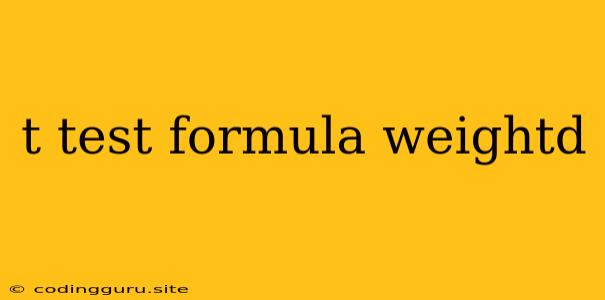Understanding the T-Test Formula for Weighted Data
The t-test is a powerful statistical tool used to compare the means of two groups. It's widely used in various fields, including healthcare, engineering, and social sciences. However, a common challenge arises when dealing with datasets where data points carry varying levels of importance. This is where the weighted t-test comes into play.
When to Use a Weighted T-Test?
Imagine conducting a survey on customer satisfaction. Some customers may have purchased multiple products, making their feedback more valuable than those who only bought one item. In such scenarios, a simple t-test wouldn't accurately reflect the true difference in satisfaction levels. This is because it treats all responses equally.
The weighted t-test addresses this by assigning weights to each data point based on its importance. This ensures that data points with greater influence have a stronger impact on the final result.
The Formula Behind the Weighted T-Test
The formula for the weighted t-test is slightly different from the standard t-test. It incorporates the weights into the calculation of the means, standard deviations, and degrees of freedom.
Here's the breakdown:
-
Weighted Mean: Instead of calculating the average directly, the weighted mean is calculated as the sum of each data point multiplied by its weight, divided by the sum of all weights.
Weighted Mean = (w1 * x1 + w2 * x2 + ... + wn * xn) / (w1 + w2 + ... + wn)where:
- wi represents the weight of data point i
- xi represents the value of data point i
-
Weighted Standard Deviation: Similar to the mean, the standard deviation is also adjusted to consider the weights. The formula involves calculating the weighted variance and then taking its square root.
-
Degrees of Freedom: The degrees of freedom are also adjusted based on the weights. The exact calculation depends on the specific type of weighted t-test being used.
How to Interpret the Results
The results of the weighted t-test are interpreted similarly to the standard t-test.
You'll obtain a t-statistic and a p-value:
- T-statistic: This represents the difference between the two weighted means, standardized by the pooled standard deviation.
- P-value: This indicates the probability of observing such a difference in means by chance, assuming there is no real difference between the groups.
If the p-value is below the significance level (typically 0.05), you reject the null hypothesis and conclude that there is a statistically significant difference between the two groups.
Example: Weighted T-Test in Action
Let's consider an example where we want to compare the average customer satisfaction scores of two products, A and B. However, some customers have purchased multiple products, making their feedback more valuable.
| Customer | Product | Satisfaction Score | Purchases |
|---|---|---|---|
| 1 | A | 4 | 1 |
| 2 | A | 5 | 2 |
| 3 | A | 3 | 1 |
| 4 | B | 2 | 1 |
| 5 | B | 4 | 3 |
| 6 | B | 3 | 2 |
We can assign weights to each customer based on their number of purchases:
| Customer | Product | Satisfaction Score | Purchases | Weight |
|---|---|---|---|---|
| 1 | A | 4 | 1 | 1 |
| 2 | A | 5 | 2 | 2 |
| 3 | A | 3 | 1 | 1 |
| 4 | B | 2 | 1 | 1 |
| 5 | B | 4 | 3 | 3 |
| 6 | B | 3 | 2 | 2 |
Applying the weighted t-test formula, we can calculate the weighted mean satisfaction score for each product and determine if there's a significant difference.
Tips for Using the Weighted T-Test:
- Define Weights Carefully: Carefully consider what factors determine the importance of each data point and assign weights accordingly.
- Choose the Right Type of Weighted T-Test: There are different types of weighted t-tests, each suited for specific situations.
- Use Statistical Software: Software like SPSS or R can simplify the calculations and provide insightful visualizations.
Conclusion
The weighted t-test is a valuable tool for analyzing datasets where data points have varying levels of importance. By incorporating weights into the calculations, it provides a more accurate and insightful assessment of the differences between groups. By understanding the formula and its applications, you can effectively analyze weighted data and draw reliable conclusions.
